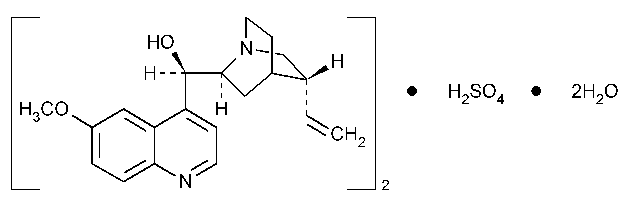Quinine Sulfate
Cinchonan-9-ol,6¢-methoxy-,(8a,9R)-,sulfate (2:1)(salt),dihydrate.
Quinine sulfate (2:1)(salt)dihydrate [6119-70-6].
Anhydrous 746.93 [804-63-7].
»Quinine Sulfate is the sulfate of an alkaloid obtained from the bark of species of Cinchona.It contains not less than 99.0percent and not more than 101.0percent of total alkaloid salt,calculated as (C20H24N2O2)2·H2SO4,on the anhydrous basis.
Packaging and storage—
Preserve in well-closed,light-resistant containers.
Identification—
A:
A1in 2000solution in dilute sulfuric acid (1in 350)exhibits a vivid blue fluorescence.On the addition of a few drops of hydrochloric acid,the fluorescence disappears.
B:
In the test for Chromatographic purity,the RFvalue of the principal spot obtained from the Test preparationcorresponds to that from the Standard preparation.
C:
Asolution (1in 50)made with the aid of a few drops of hydrochloric acid responds to the tests for Sulfate á191ñ.
Specific rotation á781Sñ:
between -235 and -245
and -245 .
.
Test solution:
20mg per mL,in 0.1Nhydrochloric acid.
Water,Method Iá921ñ:
between 4.0%and 5.5%.
Residue on ignition á281ñ:
not more than 0.1%.
Heavy metals,Method IIá231ñ:
0.001%.
Chloroform-alcohol-insoluble substances—
Warm 2g with 15mLof a mixture of chloroform and dehydrated alcohol (2:1)at about 50 for 10minutes.Filter through a tared,sintered-glass filter,using gentle suction.Wash the filter with five 10-mLportions of the chloroform-alcohol mixture,dry at 105
for 10minutes.Filter through a tared,sintered-glass filter,using gentle suction.Wash the filter with five 10-mLportions of the chloroform-alcohol mixture,dry at 105 for 1hour,and weigh:the weight of the residue does not exceed 2mg (0.1%).
for 1hour,and weigh:the weight of the residue does not exceed 2mg (0.1%).
Chromatographic purity—
Standard preparation—
Prepare a solution of USP Quinine Sulfate RSin diluted alcohol to contain 6mg per mL.
Diluted standard preparation—
Dilute a portion of the Standard preparationwith diluted alcohol to a concentration of 0.06mg per mL.
Related substances preparation—
Prepare a solution in diluted alcohol containing in each mL0.05mg each of USP Quininone RS(corresponding to 0.06mg of the sulfate),and 0.10mg of cinchonidine (corresponding to 0.12mg of the sulfate).
Test preparation—
Prepare a solution of Quinine Sulfate in diluted alcohol to contain 6mg per mL.
Procedure—
Apply 10-µLportions of the Test preparation,the Standard preparation,the Diluted standard preparation,and the Related substances preparationto a suitable thin-layer chromatographic plate (see Chromatography á621ñ)coated with a 0.25-mm layer of chromatographic silica gel.Allow to dry,and develop the chromatogram in a solvent system consisting of a mixture of chloroform,acetone,and diethylamine (5:4:1),the solvent chamber being used without previous equilibration.When the solvent front has moved about 15cm,remove the plate from the chamber,mark the solvent front,and allow the solvent to evaporate.Spray the chromatogram with glacial acetic acid.Locate the spots on the plate by examination under long-wavelength UVlight.Any spot produced by the Test preparationat the RFvalue of a spot produced by the Related substances preparationis not greater in size or intensity than that corresponding spot.Apart from these spots and from the spot appearing at the RFvalue of Quinine Sulfate,any additional fluorescent spot is not greater in size or intensity than the spot of the Diluted standard preparation.Spray the plate with potassium iodoplatinate TS.Any spot produced by the Test preparationis not greater in size or intensity than a corresponding spot from the Related substances preparation.
Limit of dihydroquinine sulfate—
Methanesulfonic acid solution—
Add 35.0mLof methanesulfonic acid to 20.0mLof glacial acetic acid,dilute with water to 500mL,and mix.
Diethylamine solution—
Dissolve 10.0mLof diethylamine in water to obtain 100mLof solution.
Mobile phase—
Prepare a suitable filtered and degassed mixture of water,acetonitrile,Methanesulfonic acid solution,and Diethylamine solution(860:100:20:20).Adjust with Diethylamine solutionto a pHof 2.6if found to be lower.
System suitability preparation—
Transfer about 10mg each of quinine sulfate and dihydroquinine to a 50-mLvolumetric flask.Dissolve in about 5mLof methanol,dilute with Mobile phaseto volume,and mix.
System suitability test—
Chromatograph injections of the System suitability preparationas directed for Procedure:the relative retention times for quinine and dihydroquinine are about 1and 1.5,respectively.The resolution between the quinine and dihydroquinine peaks is not less than 1.2.The relative standard deviation for the peak response of quinine is not more than 2.0%.
Test preparation—
Transfer about 20mg of Quinine Sulfate to a 100-mLvolumetric flask,dissolve in and dilute with Mobile phaseto volume,and mix.
Procedure
(see Chromatography á621ñ)—Inject about 50µLof the Test preparationinto a chromatograph equipped with a 235-nm detector and a 3.9-mm ×30-cm column that contains packing L1.The response of the dihydroquinine peak is not greater than one-ninth that of the quinine peak (10.0%).
Organic volatile impurities,Method IVá467ñ:
meets the requirements.
Assay—
Dissolve about 200mg of Quinine Sulfate,accurately weighed,in 20mLof acetic anhydride,add 4drops of p-naphtholbenzein TS,and titrate with 0.1Nperchloric acid VSfrom a 10-mLmicroburet to a green endpoint.Perform a blank determination,and make any necessary correction.Each mLof 0.1Nperchloric acid is equivalent to 24.90mg of total alkaloid salt,calculated as (C20H24N2O2)2·H2SO4.
Auxiliary Information—
Staff Liaison:Behnam Davani,Ph.D.,MBA,Senior Scientist
Expert Committee:(PA7)Pharmaceutical Analysis 7
USP28–NF23Page 1697
Phone Number:1-301-816-8394
